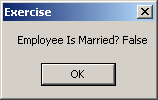|
Fundamentals of Boolean Values
|
|
|
|
A value is referred to as Boolean if it can be either
true or false. Like a number or a string, a Boolean value can be
stored in a variable. To declare such a variable, use the Boolean
keyword. Here is an example:
Public Module Exercise
Public Function Main() As Integer
Dim EmployeeIsMarried As Boolean
Return 0
End Function
End Module
|
To actually use a Boolean variable, you can assign a
value to it. By default, if you declare a Boolean variable but do not
initialized it, it receives a value of False:
Public Module Exercise
Public Function Main() As Integer
Dim EmployeeIsMarried As Boolean
MsgBox("Employee Is Married? " & EmployeeIsMarried)
Return 0
End Function
End Module
This would produce:

To initialize a Boolean variable, assign it a
True or a False value. In the Visual Basic language, a
Boolean variable can also deal with numeric values. The False value is
equivalent to 0. For example, instead of False, you can initialize a
Boolean variable with 0. Any other numeric value, whether positive or
negative, corresponds to True:
Public Module Exercise
Public Function Main() As Integer
Dim EmployeeIsMarried As Boolean
EmployeeIsMarried = -792730
MsgBox("Employee Is Married? " & EmployeeIsMarried)
Return 0
End Function
End Module
The number can be decimal or hexadecimal:
Public Module Exercise
Public Function Main() As Integer
Dim EmployeeIsMarried As Boolean
EmployeeIsMarried = &HFA26B5
MsgBox("Employee Is Married? " & EmployeeIsMarried)
Return 0
End Function
End Module
|
Passing a Boolean Variable as Argument
|
|
As done with the other data types we have used so
far, a Boolean values can be involved with a procedure. This means that
a Boolean variable can be passed to a procedure and/or a function can be
made to return a Boolean value.
To pass an argument as a Boolean value, in the
parentheses of the procedure, type the name of the argument followed by
the As Boolean expression. Here is an example:
Private Sub CheckingEmployee(ByVal IsFullTime As Boolean)
End Sub
In the same way, you can pass as many Boolean
arguments as you need, and you can combine Boolean and non-Boolean
arguments as you judge necessary. Then, in the body of the procedure,
use (or don't use) the Boolean argument.
|
Returning a Boolean Value
|
|
Just as done for the other data types, you can
create a function that returns a Boolean value. When declaring the
function, specify its name and the As Boolean expression on the
right side of the closing parenthesis. Here is an example:
Public Function IsDifferent() As Boolean
End Function
Of course, the function can take arguments of any
kind you judge necessary:
Public Function IsDifferent(ByVal Value1 As Integer,
ByVal Value2 As Integer) As Boolean
End Function
In the body of the function, do whatever you judge
necessary. Before exiting the function, you must return a value that
evaluates to True or False.